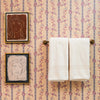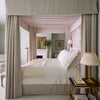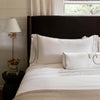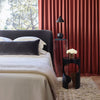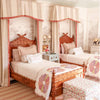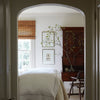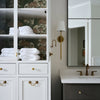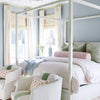Bedding Terms: A Glossary of Linens Terminology
With so many varieties of bedding available—each with unique fabrics, stitching, and specific purposes—it can be overwhelming to navigate all the options. That’s why we’ve created an easy-to-use linens glossary, covering essential bedding terms to help you make the best choices for your comfort and style.
A | B | C | D | E | F | G | H | I | J | K | L | M | N | O | P | Q | R | S |T | U | V | W | X | Y | Z | FAQs
Bedding Glossary
Applique / Appliqué
A surface decorated, sewn or embroidered, or otherwise attached to the fabrics.
Back Coating
Fabric treated with sizing on the back only to give added weight, strength and opacity.
Bed Skirt
Fabric (some decorative) that is placed between the mattress and box spring, extending to the floor to cover the lower portion of the bed and conceal the boxspring and bed frame. Learn more on how to use a bed skirt with our bed skirt guide.
Bedspreads
Full-sized bed covers that extend to the floor on all sides of the bed, designed to cover the entire bed and eliminate the need for a bed skirt - also called a coverlet or quilt.
Binding
The finishing of fabric that has been sewn on to cover seams or unfinished edges. Referred to as “self-binding” when in the same color and fabric as the base fabric; as seen on our All Seasons Cotton Blanket. Contrasting binding is of a different color, pattern or fabric.
Blanket Stitch
A closely spaced stitch that forms a line of closely spaced loops at the edge. It is used in embroidery for purely decorative purposes. As seen on our Alta Reversible Cotton Blanket.
Bleaching
A necessary process to remove the natural and artificial impurities in fabrics to obtain clear whites even dyeing and printing. Learn more about bleaching and care from our Care Guide.
Bouclé
A textured fabric featuring loops and curls on the surface, often used in decorative accents.
Bourdon Stitching
A close, narrow row of decorative, raised stitching such as a monogram, finished edge or accent.
Cambric
Usually a thin, white closely-woven cotton fabric treated to give a slight gloss. Normally used for pillows and duvet shells
Carding
A process of cleaning fibers by separating and laying them parallel to each other; most commonly performed with wool fibers.
Chenille
A fuzzy cotton yarn or fabric that has pile protruding around it. Chenille is the French word for caterpillar.
Chintz
Cotton fabric produced by passing the fabric between heated rollers under pressure. This glazed cotton is often printed with figures and large flower designs. Used widely in upholstery fabrics.
Combing
A process for removing short fibers; most often with wool. The process enables cotton to be spun into very fine, lustrous yarn for high quality fabrics.
Comforter
A thick, quilted, fluffy blanket used as the top blanket on beds, often filled with synthetic fiber fillers or natural materials like down to provide warmth. Learn more about the difference between a duvet vs comforter with our bedding guide.
Comforter Cover
Also a duvet cover; A thick, quilted, fluffy blanket used as the top blanket on beds, often filled with synthetic fiber fillers or natural materials like down to provide warmth.
Comforter Set
Also a duvet set; A set typically consisting of a comforter and two coordinating pillow shams, providing a coordinated look for a bed. Learn more about the difference between a duvet vs comforter
Cotton
Cotton is the single most popular fabric purchased by American consumers today. Cotton's popularity stems from the fiber's inherent benefits, such as comfort and the sensation of softness when touching cotton fabrics.
Coverlet
Lightweight bed covers, often woven, that can be used alone or as an additional layer for warmth with other bed linens. Also referred to as quilts or bedspreads
Crepe
A lightweight fabric with a surface that is more or less crinkled according to the method used. Crepes are made in every variety of fibers.
Damask
A woven cotton fabric made on a jacquard loom that has an alternating satin and matte texture. Damask fabrics are reversible.
Dobby
Woven on a dobby loom, this fabric can be made with a dot or geometric design.
Down
The fluffy filament cluster found under the feathers of geese or ducks that insulates and protects them from the elements. Down vs down alternative is a common question when choosing duvets!
Down Alternative
Synthetic fill options that have down-like properties and can mimic the warmth, loft, and insulating characteristics of down without reaction to allergens; alternatives may be rayon, polyester, Dacron®, or other technology fibers.
Eyelet
A style of decorative fabric stitched with small cut out openings.
Embossing
A pressure process using engraved rollers and heat application to produce raised or relief patterns on the surface of the fabric.
Faggoted
A decorative trim created by pulling out horizontal threads from a fabric and gathering the remaining cross threads into an hourglass shape.
Fill Power (or Loft)
The quality indicator of down represented by the amount of space one ounce of down will occupy in cubic inches when allowed to reach its maximum loft. Loft is the fluffiness of the down as it is related to its insulating power. Larger, more mature birds from the coldest climates produce the largest clusters. Larger clusters result in a higher loft of a down product.
Flange
A border around the edge of bedding pieces that forms a "frame" adding an extra frame.
Gusset
Refers to the depth of a mattress.
Hand
A characteristic of fabric that is perceived through touching, squeezing or rubbing.
Hemstitching
A decorative stitching along the stitch lines of hems and borders to create an open weave pattern.
Hypoallergenic Bedding
Containing few or no irritating substances in order to minimize the likelihood of an allergic reaction.
Jacquard
A loom as well as a type of intricate fabric woven on a jacquard loom. The loom produces elaborate cloth weaves such as tapestries, brocades, and damask fabrics.
Lock Stitch
A type of stitch consisting of two threads that are interlocked at short intervals. A lock-stitched terry does not pull easily.
Matelassé
Matelassé is French for “quilted” or “cushioned,” and in usage with fabric, refers to quilted textiles. Matelassé styles are meant to mimic the style of hand-stitched Marseilles-type quilts made in France.
Mercerization
A fuzzy cotton yarn or fabric that has pile protruding around it.
Micro modal
A natural fiber mad of 100% Beachwood cellulose that adds lasting softness to fabrics.
Muslin
Cotton sheeting fabric with thread count of less than 180 threads per square inch.
Percale
Usually made with combed yarns, this closely woven cotton fabric has a thread count of 180 threads per square inch or higher. Percale sheets are plain in weave and characterized by a matte finish and crisp hand. Just like your favorite crisp white shirt, percale sheets are a bedroom must-have, especially during the hot summer months. Our cotton percale linens are light and invigorating yet incredibly soft. Percale sheets are lighter in weight and more breathable, making them perfect for summertime or warmer climates.
Picot
A narrow row of dainty holes produced to create an edge or a finished flange.
Plisse
Produced by a wet finishing treatment, this fabric has the look of woven seersucker, similar to crepe.
Pilling
Occurs as a result of fibers loosening from the fabric surface to form balls of matted fiber particles.
Pique
A stiff, durable ribbed fabric with an embossed pattern produced by a double warp thread.
Sanforinzed
A process to preshrink fabric. Fabrics with this trademark should never shrink more than 1%
Sateen
A weave construction for mercerized cotton fabrics which produces a smooth, lustrous surface. Sateen cotton is woven to create a silky smooth surface with a luminous sheen and is known for its luster and drape. Sateen sheets are usually a little thicker and more tightly woven. Sateen sheets have a soft, inviting touch, and are perfect to snuggle into bed with during the cold winter months.
Scalloped Edge
A border that contains continuous curves finished with bourdon stitching.
Shrinkage
The contraction of a fiber, yarn or fabric after washing and drying. All products made of natural fibers have a tendency to shrink 4%-8%.
Terry cloth
Type of cloth that has uncut loops on the pile.
Thread count
The number of yarns per square inch in a woven fabric. The higher the count, the finer the fabric, but thread count is often used to mislead shoppers as thread count is only part of the quality equation.
Ticking
A very durable striped linen or cotton fabric with a twill weave. This closely woven material is primarily used for mattress and pillow coverings.
Twill
This type of weave is characterized by the lines that are ribbed diagonally across the fabric.
ULTRA15CLEAN® Process
A proprietary sterilization process that includes 15 down washings with further treatment in a steam dryer at 120 degrees Centigrade/248 degrees Fahrenheit.
Viscose
An industry term used to describe the most common type of ryano.
Waffle cloth
A honeycomb weave usually of cotton or wool, used mainly for towels and robes.
Warp thread
The set of fixed threads that are set lengthwise across the fabrics.
Weft
The crosswise threads of any woven fabric.
White Bedding
The grand dame of luxury bedding is white sheets. When in doubt, you can never go wrong with white sheets. White sheets will always go with anything and everything. Plus, white sheets offer a blank canvas to create any look you want! There is nothing better than freshly washed white sheets.
Woof
The threads that cross the warp of a woven fabric, the weft.
Yarn dyed fabrics
Fabrics that are woven with yarns that have been dyed prior to the fabrication of the cloth. Usually used to produce multi-colored striped, plaid or jacquard effects. The extra step of dyeing these yarns enhances color consistency and vibrancy. This type of fabric is different from piece dyed, whereby the complete fabric is dyed after weaving.
Bedding FAQs
What are the basic parts of bedding?
The basic parts of bedding include a fitted bed sheet, top sheet, top blanket, pillows with pillowcases and a bed skirt. The top blanket could be a duvet with a duvet cover, quilt or blanket. Additional pillows with pillow sham covers are often chosen to provide decoration and luxury comfort.
How many different layers are in bedding?
There are three basic layers in bedding:
- Fitted layer - the bed skirt and fitted sheet.
- Top layer - the flat sheet and top blanket or duvet.
- Pillows - sleeping pillows and decorative pillows.
What are the parts of a duvet?
A duvet is made up of a duvet insert and a duvet cover. The duvet insert is similar to a pillow while a duvet cover is similar to a pillow case. Many prefer this European sleeping style to wash the duvet cover routinely and sleep well with this alternative to a blanket or comforter.
How many types of bed sheets does Peacock Alley offer?
We offer the following sheets by fabric:










